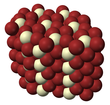| Revision as of 11:00, 13 May 2011 editLamro (talk | contribs)Autopatrolled, Extended confirmed users84,339 edits {{Praseodymium compounds}}← Previous edit | Revision as of 11:11, 13 May 2011 edit undoCheMoBot (talk | contribs)Bots141,565 edits Updating {{chembox}} (no changed fields - added verified revid - updated 'UNII_Ref', 'ChemSpiderID_Ref', 'StdInChI_Ref', 'StdInChIKey_Ref', 'ChEMBL_Ref', 'KEGG_Ref') per Chem/Drugbox validation (Next edit → | ||
| Line 1: | Line 1: | ||
| {{chembox | {{chembox | ||
| | verifiedrevid = |
| verifiedrevid = 417316717 | ||
| | Name = Praseodymium(III) chloride | | Name = Praseodymium(III) chloride | ||
| | ImageFile = Praseodymium(III)-chloride-heptahydrate.jpg | | ImageFile = Praseodymium(III)-chloride-heptahydrate.jpg | ||
Revision as of 11:11, 13 May 2011
 | |||
| |||
| Names | |||
|---|---|---|---|
| IUPAC name Praseodymium(III) chloride | |||
| Other names Praseodymium chloride; praseodymium trichloride | |||
| Identifiers | |||
| CAS Number | |||
| ECHA InfoCard | 100.030.710 | ||
| CompTox Dashboard (EPA) | |||
| Properties | |||
| Chemical formula | PrCl3 | ||
| Molar mass | 247.24 g/mol (anhydrous) 373.77 g/mol (heptahydrate) | ||
| Appearance | blue-green solid (anhydrous) light green solid (heptahydrate) | ||
| Density | 4.02 g/cm (anhydrous) 2.250 g/cm (heptahydrate) | ||
| Melting point | 786 °C | ||
| Boiling point | 1710 °C | ||
| Solubility in water | 104.0 g/100 ml (13°C) | ||
| Structure | |||
| Crystal structure | hexagonal (UCl3 type), hP8 | ||
| Space group | P63/m, No. 176 | ||
| Coordination geometry | Tricapped trigonal prismatic (nine-coordinate) | ||
| Hazards | |||
| Occupational safety and health (OHS/OSH): | |||
| Main hazards | Irritant | ||
| Related compounds | |||
| Other anions | Praseodymium(III) fluoride Praseodymium bromide praseodymium iodide | ||
| Other cations | Cerium(III) chloride Neodymium(III) chloride | ||
| Except where otherwise noted, data are given for materials in their standard state (at 25 °C , 100 kPa).
| |||
Praseodymium(III) chloride is the inorganic compound with the formula PrCl3. It is a blue-green solid that rapidly absorbs water on exposure to moist air to form a light green heptahydrate.
Preparation
Praseodymium(III) chloride is prepared by treating praseodymium metal and hydrogen chloride:
- 2 Pr + 6 HCl → 2 PrCl3 + 3 H2
It is usually purified by vacuum sublimation.
Hydrated salts of praseodymium(III) chloride can be prpared by treatment of either praseodymium metal or praseodymium(III) carbonate with hydrochloric acid:
- Pr2(CO3)3 + 6 HCl + 15 H2O → 2 Cl3 + 3 CO2
Anhydrous PrCl3 can be made by thermal dehydration of the hydrate at 400 °C in the presence of ammonium chloride. Alternatively the hydrate can be dehydrated using thionyl chloride.
Reactions
Praseodymium(III) chloride is Lewis acidic, classified as "hard" according to the HSAB concept. Rapid heating of the hydrate may cause small amounts of hydrolysis. PrCl3 forms a stable Lewis acid-base complex K2PrCl5 by reaction with potassium chloride; this compound shows interesting optical and magnetic properties.
Aqueous solutions of praseodymium(III) chloride can be used to prepare insoluble praseodymium(III) compounds. For example, praseodymium(III) phosphate and praseodymium(III) fluoride can be prepared by reaction with potassium phosphate and sodium fluoride, respectively:
- PrCl3 + K3PO4 → PrPO4 + 3 KCl
- PrCl3 + 3 NaF → PrF3 + 3 NaCl
When heated with alkali metal chlorides, it forms a series of ternary (compounds containing three different elements) materials with the formulae MPr2Cl7, M3PrCl6, M2PrCl5, and M3Pr2Cl9 where M = K, Rb, Cs.
References
- ^ J. Cybinska, J. Sokolnicki, J. Legendziewicz, G. Meyer Journal of Alloys and Compounds 341, 115-123 (2002).
- L. F. Druding, J. D. Corbett, J. Am. Chem. Soc. 83, 2462 (1961); J. D. Corbett, Rev. Chim. Minerale 10, 239 (1973)
- ^ F. T. Edelmann, P. Poremba, in: Synthetic Methods of Organometallic and Inorganic Chemistry, (W. A. Herrmann, ed.), Vol. 6, Georg Thieme Verlag, Stuttgart, 1997.
- M. D. Taylor, P. C. Carter, J. Inorg. Nucl. Chem. 24, 387 (1962); J. Kutscher, A. Schneider, Inorg. Nucl. Chem. Lett. 7, 815 (1971).
- J. H. Freeman, M. L. Smith, J. Inorg. Nucl. Chem. 7, 224 (1958).
- Gerd Meyer "Ternary Chlorides and Bromides of the Rare-Earth Elements" Inorganic Syntheses, 1990, Volume 30, pp. 72–81. doi:10.1002/9780470132616.ch15
Further reading
- CRC Handbook of Chemistry and Physics (58th edition), CRC Press, West Palm Beach, Florida, 1977.
- N. N. Greenwood, A. Earnshaw, Chemistry of the Elements, Pergamon Press, 1984.
- S. Sugiyama, T. Miyamoto, H. Hayashi, M. Tanaka, J. B. Moffat Journal of Molecular Catalysis A, 118, 129-136 (1997).
- Druding L. F., Corbett J. D., Ramsey B. N. (1963). "Rare Earth Metal-Metal Halide Systems. VI. Praseodymium Chloride". Inorganic Chemistry. 2 (4): 869–871. doi:10.1021/ic50008a055.
{{cite journal}}: CS1 maint: multiple names: authors list (link)
| Praseodymium compounds | |||
|---|---|---|---|
| Pr(II) | |||
| Pr(III) |
| ||
| Pr(III,IV) | |||
| Pr(IV) | |||
| Pr(V) | |||

